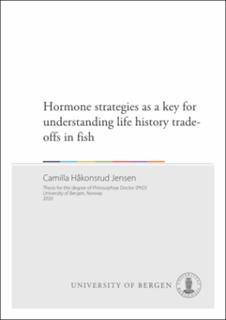| dc.contributor.author | Jensen, Camilla Håkonsrud | |
| dc.date.accessioned | 2020-04-15T13:22:28Z | |
| dc.date.available | 2020-04-15T13:22:28Z | |
| dc.date.issued | 2020-04-21 | |
| dc.date.submitted | 2020-04-06T12:59:55.107Z | |
| dc.identifier | container/5f/84/18/84/5f841884-7d03-49fa-b6fb-757bba64ce30 | |
| dc.identifier.uri | http://hdl.handle.net/1956/21876 | |
| dc.description.abstract | Animal behaviour has fascinated humans for millennia. For studying animal behaviour, evolutionary biologists have focused primarily on their ultimate fitness causes mainly using a top-down approach. In contrast, physiologists have concentrated on the proximate causes of behaviour adopting primarily a bottom-up approach. This difference in focus and methodology has caused a conceptual rift between the fields. To take part in narrowing this rift, this thesis has aimed to unite proximate mechanisms with ultimate evolutionary explanations. To reach this goal, we developed a digital modelling tool that describes the relationship between a simplified endocrine system and the behaviour of a generalised juvenile fish. The model shows that the optimal growth hormones levels in juvenile fish decrease with size together with size-dependent mortality risk, while hormones that affect appetite and metabolism are kept relatively stable throughout the growth period. When comparing stable environments, we also found that optimal hormone levels increase with food availability. In variable environments with partly predictable food availability, hormone levels increase when food availability is temporarily high, while they decrease when food availability is temporarily poor. In this way, we found that it is optimal for fish to: <ul> move their mortality costs over time by primarily foraging and growing when food availability is rich, build their energy reserves when food availability is at an intermediate level, and wait for the environment to improve when it is poor. </ul> When a fish, in addition to living in a variable environment, is exposed to a parasite that only has an energetic cost to the host, its optimal compensation strategy is to increase its hormone levels and thus its growth, foraging and metabolism. As a result, fish also show increased predation mortality with increasing parasite costs. These are signs often associated with parasite manipulation, but the parasites in our model only take energy from the host and is devoid of any strategy. In conclusion, we thus find that dynamic hormone levels have the potential to evolve as a unified strategy that affects survival and growth during the growth phase of juvenile fish. The model also indicates that such a hormone strategy can be adaptive to prepare the phenotype of a juvenile fish for the food availability and parasite costs that are likely to come in its environments. In addition we find that behavioural and physiological changes following an infection might in some cases be the result of a co-evolved mixed phenotype of both the host and parasite, where both behave according to their own adaptive strategies. Using an approach including both proximate mechanisms and ultimate evolutionary explanations thus have the potential to increase our understanding of animal behaviour. | en_US |
| dc.language.iso | eng | eng |
| dc.publisher | The University of Bergen | en_US |
| dc.relation.haspart | Paper I: Weidner, J., Jensen, C.H., Giske, J., Eliassen, S. & Jørgensen, C. (2020). Hormones as adaptive control systems in juvenile fish. Biology Open, 9: bio046144. The article is available at: <a href="http://hdl.handle.net/1956/21869" target="blank">http://hdl.handle.net/1956/21869</a> | en_US |
| dc.relation.haspart | Paper II: Jensen, C.H., Weidner, J., Giske, J., Budaev, S., Jørgensen, C. & Eliassen, S. Hormonal regulation of growth and survival in variable environments. The article is not available in BORA. | en_US |
| dc.relation.haspart | Paper III: Jensen, C.H., Weidner, J., Mennerat, A., Giske, J., Jørgensen, C. & Eliassen, S. Apparent manipulation: How parasites may modify their host’s behaviour without using any tricks. The article is not available in BORA. | en_US |
| dc.rights | In copyright | eng |
| dc.rights.uri | http://rightsstatements.org/page/InC/1.0/ | eng |
| dc.title | Hormone strategies as a key for understanding life history trade-offs in fish | en_US |
| dc.type | Doctoral thesis | |
| dc.date.updated | 2020-04-06T12:59:55.107Z | |
| dc.rights.holder | Copyright the Author. All rights reserved | en_US |
| dc.contributor.orcid | https://orcid.org/0000-0001-7557-7742 | |
| fs.unitcode | 12-60-0 | |
